SABR 50 at 50: Baseball Cards
As part of the SABR 50 at 50 project to commemorate the organization’s fiftieth anniversary, the SABR Baseball Cards Committee offers 50 cards for the past 50 years.
This isn’t a ranking or even a list of the “best” card for each year but rather a look at the hobby as it has changed over the past five decades and the way the history of baseball has been reflected in cards over that same time.
We invite you to read the list and the short description for each of the cards. Click on the title to read stories from the SABR Baseball Cards Blog, the SABR BioProject, or other baseball authors about these cards or the players pictured in them.
Click on the card image itself to show front and back sides of each card.
— Compiled by Nick Vossbrink and Jason Schwartz

1971 Topps: Curt FloodThis was the final year the Washington Senators appeared on cardboard, but more importantly, Curt Flood’s card captured the initial volley of the coming revolution in baseball’s labor market. That line of thirteen zeroes across his stats doesn’t come close to capturing the sacrifice Flood made by making a stand for free agency. |

1972 Topps Traded: Joe MorganUntil 1972, Topps cards didn’t really call out player movement on their fronts. Yes, we saw airbrushed uniforms and awkward poses and got an occasional updated card, but the idea of explicitly mentioning that a player had changed teams was new. It’s like Topps saw the free agency writing on the wall and the upcoming deluge of player movement that would increase year after year. That one of the first Traded cards happened to feature a key player on the Big Red Machine falling into place was only the icing on the cake. |

1973 Topps: Tommie AgeeThis was a watershed set for Topps, the last set released in multiple series (hereafter sets would be issued either complete or in just two series.) It was also the first set to go all-in on action photography. The result was a set that had one foot in the past and the other in the future. The photos feel comfortably retro, with many that share bloodlines with today’s all-action, all-exertion photos. Mix in a commitment to airbrushing anything and everything that needed to be updated, and you have a singularly distinct look for the ages. |
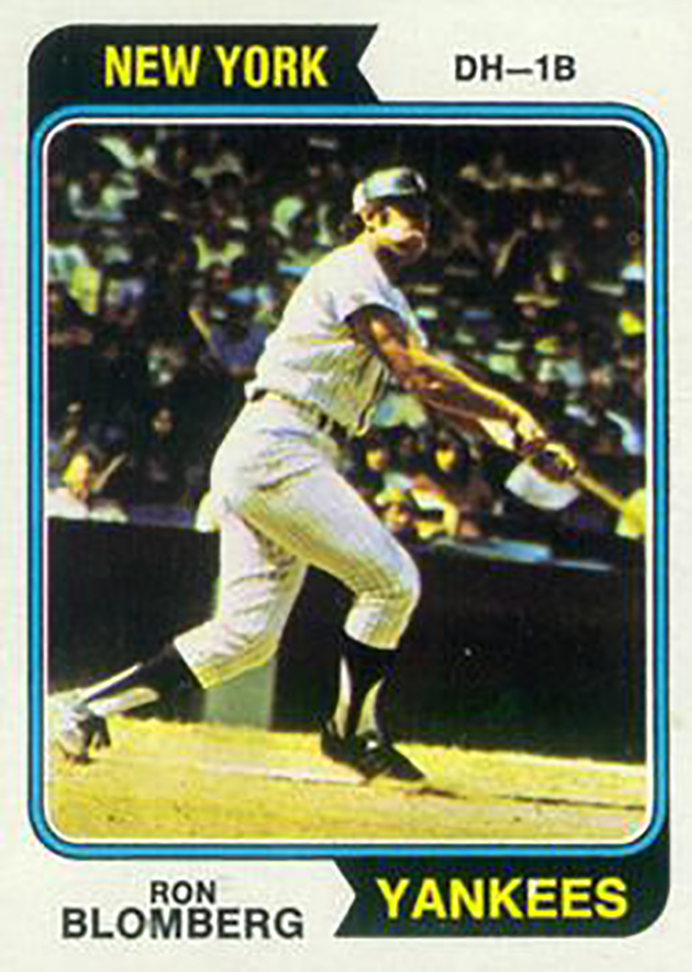
1974 Topps: Ron BlombergOn April 6, 1973 Ron Blomberg drew a bases-loaded walk and became the first designated hitter in major-league history. In 1974 Topps printed the first cards featuring this new position. In 2020, despite rules taking baseball to a universal DH, fans were still debating the merits of the original rule change in 1973. |

1975 Topps Mini: Hank AaronHank Aaron as the Home Run King could really be any years in the mid-1970s, but in 1975 his mini-variant card captured a lot of what the hobby would become. The idea of releasing a variant set was new in 1975, but it became the thing in the hobby decades later. Including highlights and record breakers in the body of the set itself was another innovation that spawned all kinds of products in the ensuing decades. What better highlight to kick things off with than the career home run record. |

1976 SSPC: Frank RobinsonWhile the copyright says 1975, the unlicensed SSPC set was really more of a 1976 issue with back information which indicates that the 1975 season had completed. This set, besides featuring a lot of fun photography, represented the first real challenge to the Topps monopoly that the hobby had seen in years. By having dedicated manager cards, it also was able to commemorate Frank Robinson becoming the first African American manager in the major leagues. |

1977 Topps Burger King: Reggie Jackson1977 was the year of Reggie Jackson, his first year in New York with his Mr. October heroics. It’s a good thing Topps managed to get him onto a card as a Yankee even if they had to airbrush the heck out of it to do so. Later that year, they got the picture right when Burger King released some of the first licensed retail “oddball” cards. In addition to featuring updated photos of new players, these oddballs kicked off an oddball boom which permeated the hobby in the 1980s and early 1990s. |

1978 Topps: Glenn BurkeWhile we can’t say if Burke was the first openly gay ballplayer or ex-ballplayer, there’s a lot of evidence to suggest that it was an open secret and most of his teammates didn’t care. Sadly, he still got pushed out of the game too soon and didn’t live long enough to receive proper recognition for the moment of joy he invented (with Dusty Baker) in 1977. Everyone gives high-fives. Everyone loves high-fives. What a wonderful legacy to be known for. |

1979 Padres Family Fun Center: The KGB ChickenWhat was that about oddballs? Mascots have existed forever but they weren’t a Baseball™ thing until the Chicken started his act in San Diego. He quickly showed up on cards, first oddball team releases, then regular releases such as the early Donruss sets. He also threw open the door to so many mascots following in his footsteps that today the few teams without them are the exceptions. |

1980 Topps: Rickey HendersonRickey may not have had the first big rookie card craze but he was clearly a sensation who was driving card speculation by 1981. As much as we wanted to avoid a list naming just the popular big-name rookie cards, some of them are too important to leave off. |
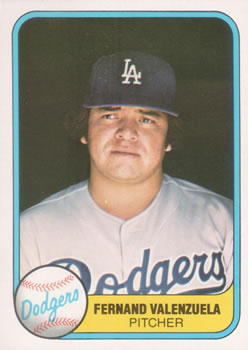
1981 Fleer: “Fernand” Valenzuela1981 brought us the end of the Topps monopoly as Fleer and Donruss released their first sets of cards. Fernando-mania turned the Dodgers into a team that Mexican Americans could root for while lamenting the loss of their Chavez Ravine community. All of this occurred despite a strike and labor negotiations which ushered in modern free agency. |

1982 Donruss Diamond Kings: Gorman ThomasIn 1982 Donruss introduced its Diamond Kings subset and reintroduced cards that were intentionally supposed to look like art to the hobby. (It’s the position of this committee that the illustrated cards of Rick Jones (1977) and Greg Minton (1978) lacked the “intent” element.) 1982 was also a good year for the Brewers in reaching that franchise’s only World Series. |

1983 Donruss Action All Stars: George BrettOversize sets have come and gone as one-off releases, but Donruss’s Action All Stars set heralded a new era of competition in the card industry, with brands going in different directions to distinguish themselves. George Brett, meanwhile, provided the highlight of the baseball season through the Pine Tar Game. |

1984 Fleer: Glenn HubbardSometimes a great photo is a great photo. After decades of traditional baseball photos, Fleer realized that branching out into the weird and wonderful would be a way to distinguish itself. Not every photo can be Glenn Hubbard holding a large snake, but throughout the 1980s Fleer repeatedly demonstrated a willingness to go goofy in its photography and, as a result, produced sets with a ton of intrinsic character. |

1985 Donruss Box Bottom: Dwight Gooden
|

1986 Sportflics: Keith HernandezSportflics entered the market in 1986 with magic motion cards featuring lenticular technology that produced short three-frame animations. While not a hit with the emerging investor/speculator market, they were something kids loved. Those kids also got to turn their cards over and learn about a new statistic, the Game-Winning RBI — which, while flawed, was wonderfully evocative. Hernandez was the all-time leader with 129 GWRBI between 1981 and 1989, when the stat was quietly discontinued. |

1987 Fleer Update: Kevin MitchellOne of the purest ideals of a baseball card set is that it should be a record of the season. This is an impossible task with press lead times and player movement, so it’s important to highlight when companies go the extra mile. In 1983, Fleer had a Joel Youngblood highlight but they took things even further in 1987 by releasing a card featuring Kevin Mitchell with both of the teams he actually played for that year. |
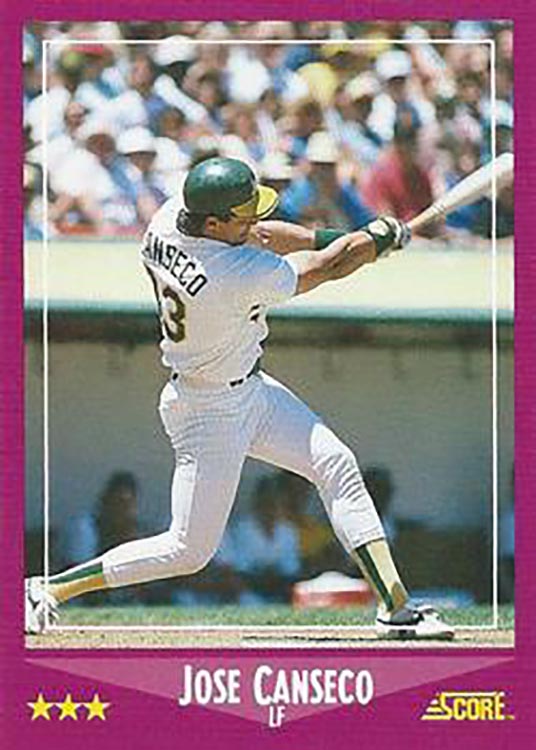
1988 Score: Jose CansecoAnother new company entered the market in 1988 and this time it was a game-changer. Score featured action photography like no other set and encyclopedic backs with enough information for kids to read all summer. 1988 was also the year of Jose Canseco, who became the first member of baseball’s 40-40 club, took the A’s to the World Series, and kicked off an awareness of steroids and performance-enhancing drugs that would come to dominate the sport in the following decades. |

1989 Upper Deck: Ken Griffey Jr.By 1989, the market was up to six brands. While Score raised the bar in ’88, Upper Deck raised it even further with the first truly premium set. Pinning its hopes on a charismatic Seattle Mariners rookie, Upper Deck’s became the most-noteworthy set for a generation of collectors with the Ken Griffey Jr. #1 card as its centerpiece. And what a masterpiece. Not all bets pan out but in this case Griffey became one of the biggest superstars of the game and the hobby. |

1990 Upper Deck: “Find the Reggie”In previous years, base cards were considered “chase” cards. In 1990 Upper Deck released premium autographed inserts that would drive purchasing and forever change the hobby. The following year Score and Donruss followed suit. By the end of the decade we were well into the hit-focused obsession we still find ourselves in today. |

1991 Stadium Club: Nolan RyanThe early 1990s were a weird time for cards as the trend toward full-bleed premium cards intersected with a trend showing players out of uniform. While Nolan Ryan wasn’t featured in an Olan Mills shot like so many of the draft picks, his tuxedo showed him off as the king of the hobby. Stadium Club introduced foil stamping and full-bleed cards to the masses but in many ways the backs were noteworthy for showing some early sabermetrics. |

1992 Topps Gold: Cal Ripken Jr.By 1992, Cal Ripken Jr.’s chase of Lou Gehrig’s consecutive games record — which he would break three years later — had become a part of the game’s zeitgeist. No card captured this better than Topps’s card with Gehrig’s Yankee Stadium monument in a set that replaced the pink bubble gum sticks with the chance of finding a special gold foil parallel card. Along with autographed inserts and relics, these parallels would also increasingly become the driving force of the hobby. |

1993 Pacific: David NiedPacific had been making tribute sets for a number of years but 1993 was their first foray into making flagship base sets. That they were only allowed to print in Spanish meant that they produced the first Spanish-language flagship release for US distribution — acknowledging both Major League Baseball’s appeal across Latin America as well as the extent that Spanish is a native language to many US citizens and residents. 1993 was also the first year of expansion in more than a decade, with David Nied being the first player taken in the expansion draft by the Colorado Rockies. |

1994 Topps Finest: Moises AlouThe mid-season strike and subsequent cancellation of the season and World Series ruined one of the most promising Montreal Expos seasons ever and dealt the franchise a blow from which it never recovered. It also dealt a shock to the hobby. After a handful of years of phenomenal growth in market share and card-making technology — the most recent being Chrome technology which Topps introduced in 1993 — the hobby was sent into a period of increased competition over a much smaller market share. |

1995 Collectors Choice: Hideo NomoHideo Nomo and his unorthodox but captivating windup did his best to rekindle fan interest in baseball, as he spawned Nomo-mania in a Rookie of the Year-winning season with the Dodgers. After Nomo, the door to players from Japan and the rest of Asia remained open and the demographics of Major League Baseball became increasingly international. |
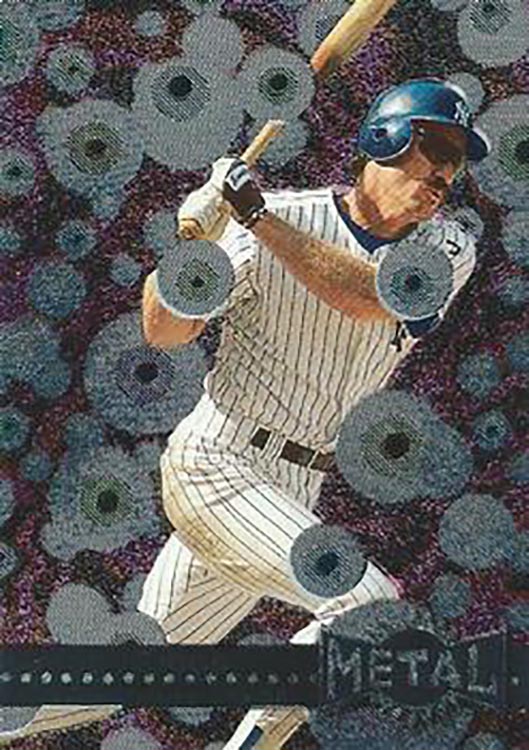
1996 Fleer Metal Universe: Wade BoggsWith interest in the game still reeling from the strike the hobby tried increasingly creative ways to distinguish cards and brands from each other with different paper stocks, surfaces, die cuts, stamping, embossing — or in the case of Fleer Metal Universe, going as over the top as possible into cartoon-land. |

1997 Topps: Jackie RobinsonMajor League Baseball marked fifty years of the color line being broken by honoring Jackie Robinson and retiring his number across all of baseball. Card companies followed suit with special releases and commemoratives. Topps, appropriately, dedicated card number 42 in his honor. |

1998 Fleer Tradition Vintage: Mark McGwireMark McGwire, Sammy Sosa, and their home run chase “saved” baseball and Fleer decided it was time to start mining the past rather than making cards as futuristic as possible. Three years after Fleer started making vintage-looking cards, Topps would launch its Heritage line. |

1999 Bowman International: Ntema NdungidiAs baseball became increasingly global, cards started featuring players’ worldwide origins. In 1998 Bowman International featured cards in Spanish and Japanese. By 1999 they had cards in Korean and, in the case of Ntema Ndungidi, Zulu. |

2000 Topps: ERA LeadersIn 1999 and 2000 baseball fans in each league got to watch two pitchers at the tops of their game. Randy Johnson and Pedro Martinez were each having unreal seasons and it’s only fitting that they appeared on a number of League Leaders cards together. |

2001 eTopps: Barry BondsWith the new millennium we saw the hobby take its first steps into online releases. eTopps cards were purchased and sold online while Topps held onto the originals. In many ways the business model remained the same as “flipping” on some modern online sites, where assets are held by a third party through multiple sales and only shipped once a buyer requests the shipment. Stocks, not bonds. Bonds became an unstoppable offensive force this year by setting the single-season home run record at 73. |

2002 Bowman Draft: Mark TeahenMichael Lewis’s Moneyball came out in 2003 and turned the 2002 Athletics, and players like Mark Teahen in particular, into a metonym for the sabermetric revolution in baseball management. It’s easy to look at this period of baseball as the steroid era, but the modern analytics era began here as well. |
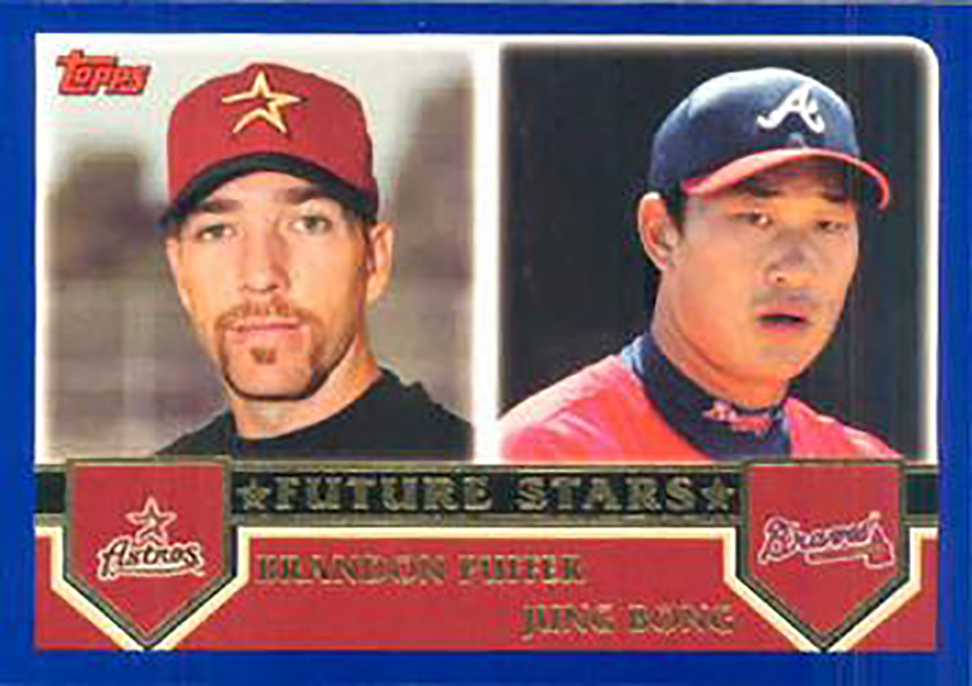
2003 Topps: Brandon Puffer / Jung BongGiven the way that Topps has assiduously removed references to beer and cigarettes from modern cards, the fact that “Bong/Puffer” not only made it all the way through production but was clearly done on purpose stands out as an exception to the sanitized modern market. Today, any potential controversy is to be avoided and sets are made to be as vanilla and unoffensive as possible. A bit of anarchic fun like this was a breath of fresh air. |

2004 Topps: David OrtizTwo years after Moneyball was published was all it took for OPS — though, interestingly, not on-base percentage — to make its first appearance on card backs. That same year, David Ortiz led the Red Sox to their first World Series title since 1918. |

2005 Topps Update: Brad WilkersonThe Montreal Expos’ relocation to Washington, D.C., and rechristening as the Nationals occurred too late for many card companies to reflect the change in sets issued in the first half of the year. As the season went on, though, Nationals cards began to circulate and Brad Wilkerson’s highlights his status as the last player to wear an Expos jersey, first player to come to bat as a National, and the first player to get a hit as a National. |

2006 Topps: Alex GordonAfter almost two decades of a rookie-card arms race that resulted in both inflation and increasing numbers of players who never played major-league ball showing up in sets, a new agreement with the MLB Players Association limited who could appear in a flagship set. This wasn’t enough to prevent Topps from releasing a card that broke the new agreement: Alex Gordon had yet to appear in a major-league game and was not on the Royals’ 25-man roster. The subsequent scramble to track down and destroy his card resulted in the first trading card to be pulled from circulation in almost 50 years. |

2007 Topps Home Run History: Barry BondsOver multiple seasons, Topps ran a Home Run History insert set featuring one card for every home run Barry Bonds hit. This set was kind of bare-bones, with multiple cards featuring the same photo and a design where the only change card-to-card was the large bold number. It does, however, capture the degree that Bonds, his home run chase, and PED rumors had taken over both the hobby and baseball discourse in general (there were more than 2,700 different Bonds cards produced in both 2005 and 2006.) When he finally broke Hank Aaron’s career record in 2007, Topps was finally able to finish its set. |

2008 Topps Moments & Milestones: Roger ClemensWith its Bonds set complete, Topps proceeded to release Moments & Milestones to honor the careers of other players. This set continued the same-look philosophy but reflected an evolution in what a baseball set could be about. Rather than being a season’s worth of players, it hearkened back to the 1959 Fleer Ted Williams set and told stories about their careers. Upper Deck released its own set with “Documentary,” whose substandard execution failed to live up to its ambition to create a card for each game of the season. In reality, the dominant point of this season was the Mitchell Report, its allegations, the game’s reckoning with over a decade of steroid use, and Roger Clemens’s countersuit to the resulting tainting of his recent Cy Young Award seasons. |

2009 Upper Deck O-Pee-Chee: Joe MauerAfter years of releasing Toppsish-looking designs under the Vintage label, Upper Deck finally found itself in hot water in 2009 when its 1975-looking design triggered a lawsuit from Topps. Both companies eventually settled but only after Topps had acquired an exclusive license to be the sole producer of cards using Major League branding. On the field, the Twins’ Joe Mauer won the MVP with one of the best offensive seasons from a catcher. |

2010 Upper Deck: Roy HalladayUpper Deck didn’t back down after Topps acquired an exclusive license and proceeded to make a 2010 set which did the bare minimum in trying to obscure team names and logos. Topps had to sue a second time to stop production of new cards and properly launch a new monopoly era. Phillies ace Roy Halladay shined on the field with a perfect game during the season, a no-hitter in the postseason, and a Cy Young Award. |

2011 Topps Update: Mike TroutIt’s only fitting that in the first year of the new monopoly, Topps managed to mint the new definitive card for the modern generation of collectors. Mike Trout announced himself as the preeminent player of the era, Topps managed to get his rookie card into Update, and over the past decade the desirability of this card has not only grown but become the lightning that every collector and card release is trying to recapture. |
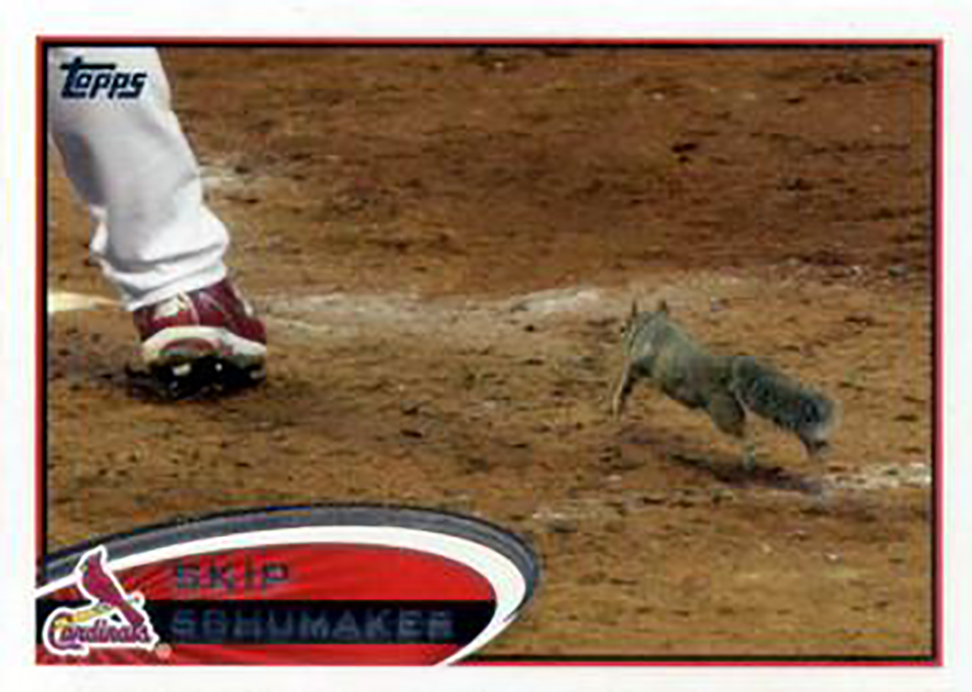
2012 Topps: Skip Schumaker Rally Squirrel VariantThis was not the first of Topps’s somewhat-dubious variant cards, but the Rally Squirrel and the resulting hype around it (including a lawsuit over who owned the trademark for Rally Squirrel) was in a category of its own. Topps’s decision to commemorate the squirrel on cardboard made sense. Their decision to do it via a short-printed variant image that ended up being “valuable,” while being a horrible card of Skip Schumaker, did not. It does, however, provide a perfect example of the nature of the modern hobby, how sets are constructed, and how the companies try to create value. |

2013 Pinnacle: Jose AltuveAfter a couple years of Topps being the only real manufacturer of current-year player cards, Panini started to leverage its brand portfolio. When it brought Pinnacle out of retirement, it discovered a certain amount of buzz and excitement around its potential as a Topps competitor. No logos or even team names were high hurdles to overcome, but Panini has slowly grown ever since, with various Donruss- and Score-inspired sets that satisfy collectors’ itches for something different and occasionally include players whom Topps is unable to license. 2013 also marked the beginning of everyday interleague play as the Astros’ move to the American League created two 15-team leagues. |
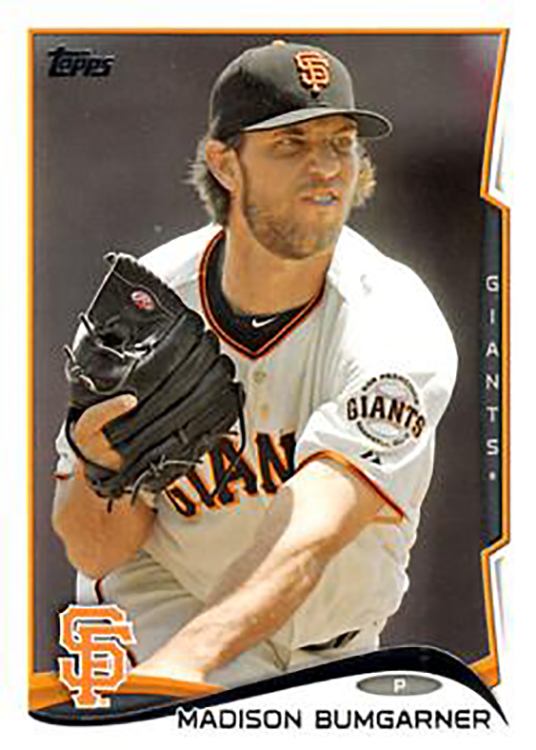
2014 Topps: Madison Bumgarner2014 brought a new statistic to the backs of cards as sabermetric influence continued to grow in the game. For the first time there was a Wins Above Replacement column on card backs and — for better or for worse — collectors now had a single number they could use to compare players across years and positions. What we don’t need WAR for, though, is to appreciate the dominance Madison Bumgarner demonstrated in the World Series for the Giants. |

2015 Topps: Kris BryantKris Bryant was the top 2015 rookie prospect but unexpectedly started the season in Triple-A. Nine games into the season — just enough to give the Cubs one more year of contractual control — he made his major-league debut. Over the following five years his resulting grievance against the Cubs, the continued service-time manipulation by Major League clubs, and increased evidence of collusion against free agents fueled concerns about an upcoming work stoppage once the next collective bargaining agreement expires. |

2016 Topps Now: Francisco LirianoTopps went big-time into on-demand, online releases with Topps Now. This was one of the most interesting and exciting card set concepts with the potential for releasing a card for any game and, through digital production, not requiring the same kind of print runs or lead times that traditionally released cards required. |

2017 Topps: Francisco LindorWhile not an explicit choice from Topps, due to Major League Baseball and Cleveland demoting Chief Wahoo from being the primary Indians logo, he also disappeared from most of this year’s cards. An end of an era but also something this committee endorses as progress. Now, the players’ social media handles that were added to the backs this year? Not something that feels like it’s going to age well. |

2018 Topps Living: Aaron JudgeTopps continued to expand its online releases with more creative ideas about what sets can be. In this case, the concept of a Living Set which, rather than being tied to a specific year reflected the current state of the league, is one which captures the imagination of the hobby. The execution, as with Topps Now, doesn’t quite live up to the promise but it’s clear that online releases are not just here to stay but a dominant part of the hobby. |

2019 Allen & Ginter: Gary VaynerchukThis was a year in which the hobby became dominated by card flipping and speculation — much of it encouraged by Topps itself. Gary Vaynerchuk suddenly become the name as the digital media entrepreneur and his followers jumped on the card collecting bandwagon and Topps gave him an imprimatur, first with an on-demand set paying homage to his life (complete with wine pairings cards that hearken back to his origins), then an insert set in Flagship, and finally a card of his own in Ginter. While we don’t doubt Vaynerchuk’s love and rediscovery of cards, the behavior of his followers has fueled what may become a speculative bubble and has worried many collectors about the long-term future of the hobby. |

2020 Topps Project: Jackie Robinson by EfdotIt started off as something many in the hobby didn’t understand, but after a month of releases, Topps Project 2020 became a sensation with print runs close to 100,000 and a secondary eBay market moving faster than cards could be shipped and priced. This was more than a baseball card phenomenon: by collaborating with professional artists, Topps created a product that brought in all kinds of new collectors and took baseball cards out of its niche. The on-demand nature of the product also allowed artists to respond to each other and tailor their creations to events going on in the larger world. Efdot’s Jackie Robinson, released during Black Lives Matter protests in the spring of 2020, appropriately reflected Jackie’s lifelong fight for civil rights and social justice. He stands out as not just the player who broke the color line but also a representative of the Negro Leagues, decades of discrimination by MLB, and the amount of work that still needs to be done in baseball and in society in general. |
Photo credits: Trading Card Database. Used by permission.


